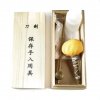- Joined
- Aug 22, 2020
- Messages
- 57
According to AoiJapan this dagger dates back to the late Edo period (1603-1868). The sheath/scabbard is not usual for that period. I understand from limited study that carrying of edged weapons was outlawed after the samurai period in Japan. It would make sense that someone wanting to carry might have had the knife fitted for the fan-like scabbard for concealment.
Anyway, I'm wondering if the knife would qualify for re-polishing and possibly re-fitting with proper accoutrements from an economic standpoint. All comments welcomed.
Well I've had it with flickr. I see that the pictures did not load. They can be seen in the request for identification thread (first response, not original post). Sorry for the inconvenience.
view-source:https://www.flickr.com/photos/189814211@N05/50331168917/in/dateposted-public/view-
source:https://www.flickr.com/photos/189814211@N05/50331163387/in/dateposted-public/view-
source:https://www.flickr.com/photos/189814211@N05/50330997811/in/dateposted-public/
view-source:https://www.flickr.com/photos/189814211@N05/50316432588/in/dateposted-public/
https://www.flickr.com/photos/189814211@N05/50317100221/in/dateposted-public/
Anyway, I'm wondering if the knife would qualify for re-polishing and possibly re-fitting with proper accoutrements from an economic standpoint. All comments welcomed.
Well I've had it with flickr. I see that the pictures did not load. They can be seen in the request for identification thread (first response, not original post). Sorry for the inconvenience.
view-source:https://www.flickr.com/photos/189814211@N05/50331168917/in/dateposted-public/view-
source:https://www.flickr.com/photos/189814211@N05/50331163387/in/dateposted-public/view-
source:https://www.flickr.com/photos/189814211@N05/50330997811/in/dateposted-public/
view-source:https://www.flickr.com/photos/189814211@N05/50316432588/in/dateposted-public/
https://www.flickr.com/photos/189814211@N05/50317100221/in/dateposted-public/

